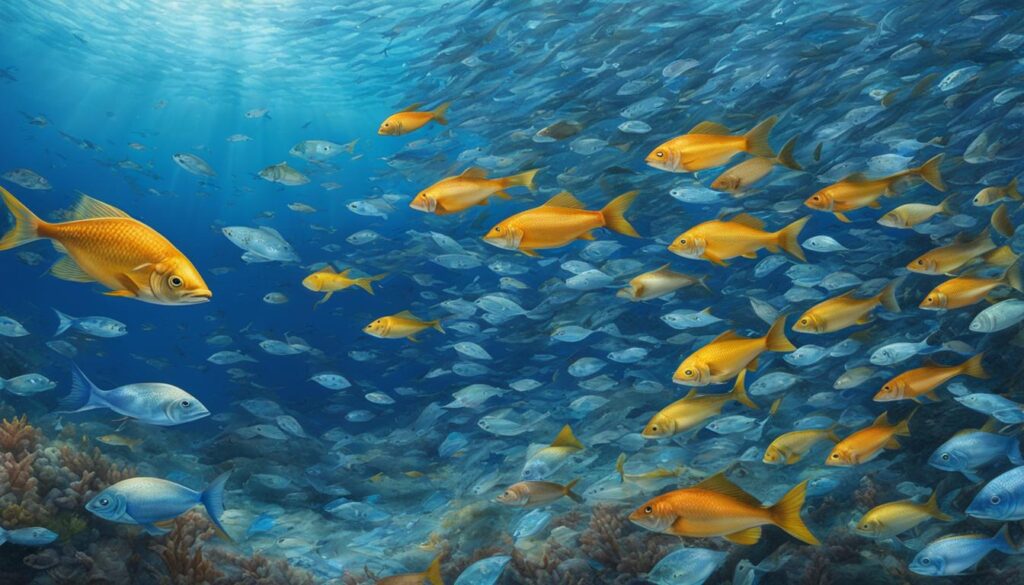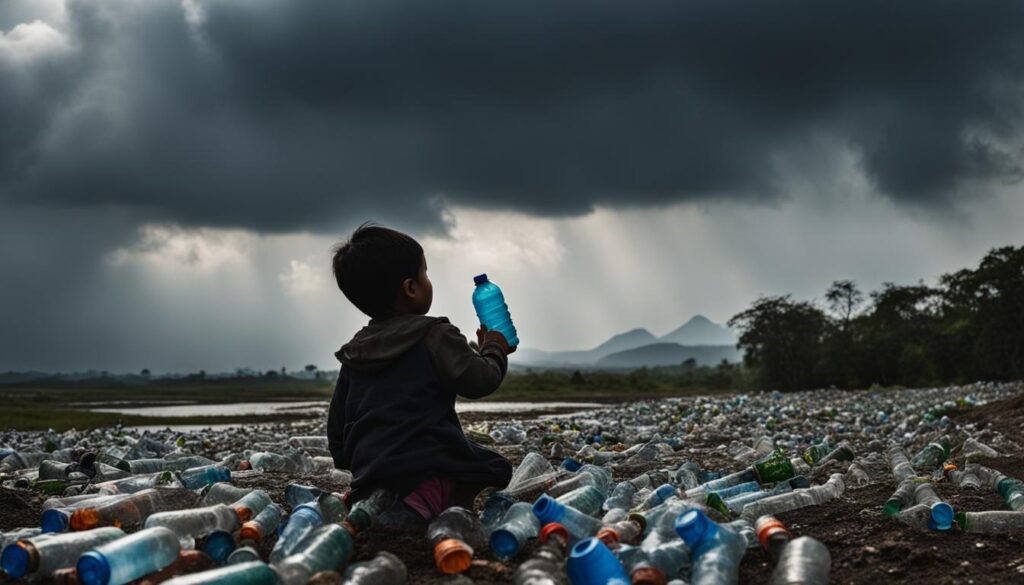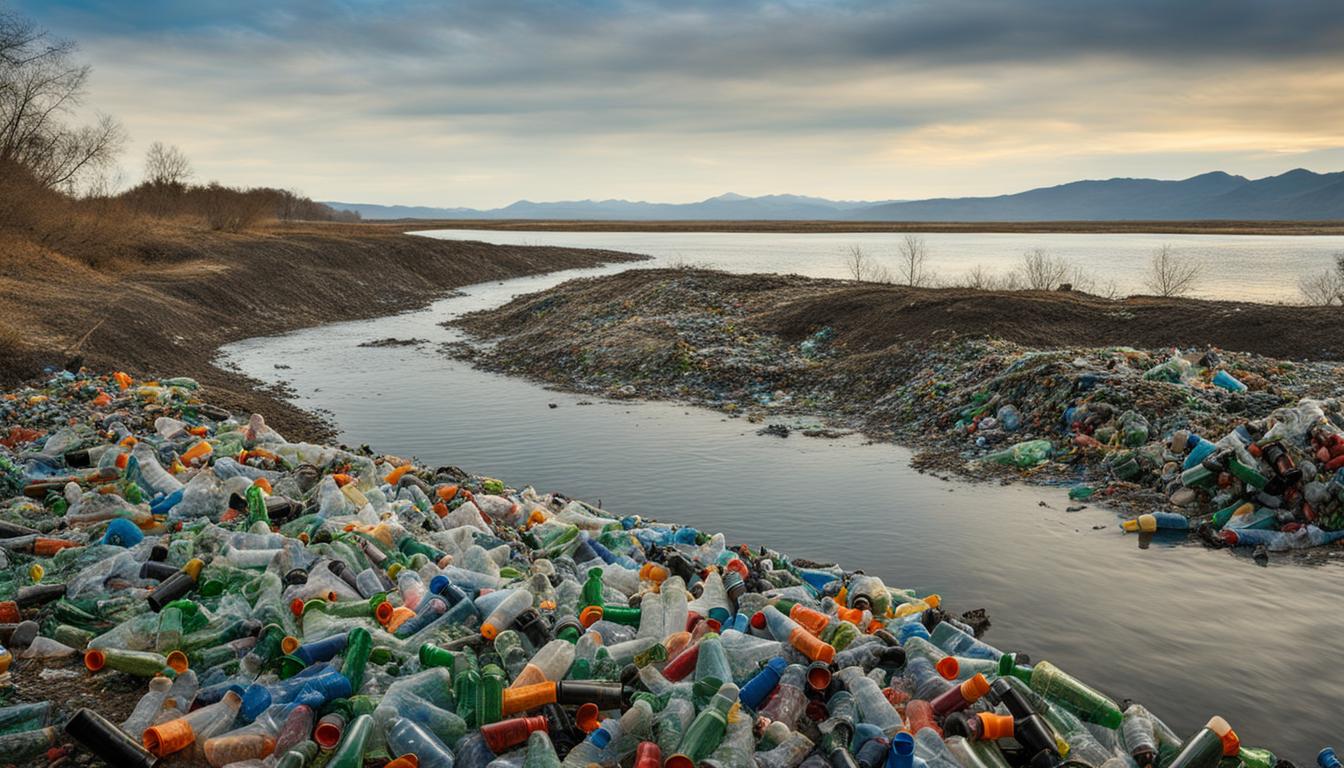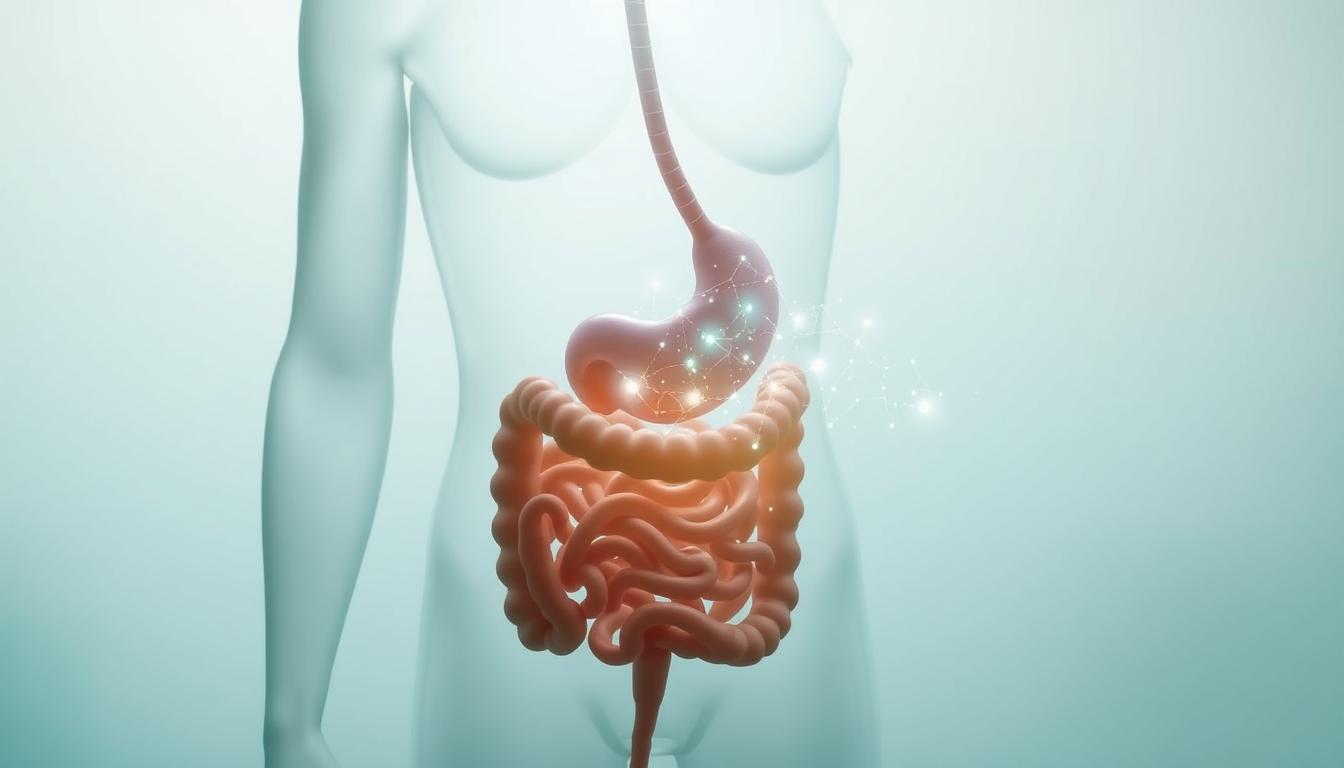The swiftly escalating consumption of bottled water has cast a spotlight on its bottled water environmental impact. Each year, our quest for convenience and perceived purity results in a massive resource footprint, with repercussions that ripple through our ecosystems. From the energy-intensive production process to the intricate journey toward recycling or, regrettably, waste, the environmental impact of bottled water emerges as a critical concern for individuals and industries alike.
Amid growing environmental awareness, the pursuit of bottled water sustainability has become a focal point for eco-conscious consumers and businesses. This scrutiny uncovers an often-overlooked narrative—the intense resource dependency and the sprawling trail of waste that accompany bottled water. Meanwhile, the industry’s gradual pivot towards innovative, eco-friendly practices hints at a potential alignment of convenience with ecological responsibility.
Key Takeaways
- Bottled water production demands vast quantities of resources, particularly oil and energy, resulting in a higher environmental footprint to that of tap water.
- The proliferation of plastic water bottles leads to severe environmental pollution due to their low recycling rate.
- Consumer health concerns loom over plastic bottles due to the possibility of chemical leaching and microplastics.
- Alternatives to traditional plastics, such as bioplastics and plant-based materials, are gaining traction in the industry.
- Mitigating the comprehensive environmental impacts necessitates informed consumer choices and dedicated industry shifts toward sustainability.
The Environmental Impact of Bottled Water
Exploring the journey from production to disposal, the environmental consequences of bottled water are far more profound than one might anticipate. Not just limited to the visual angst of water bottle litter, this modern convenience is inextricably linked with large-scale resource consumption and troubling emissions throughout its lifecycle.
Resource Consumption and Production Footprint
The process of creating the billions of plastic bottles housing our water is resource-intensive, driving a significant portion of global oil consumption. The United States alone registers a staggering annual use of over 17 million barrels of oil simply to produce water bottles. These figures underscore the magnitude of the environmental footprint left by our bottled hydration preferences, deeply intertwined with the heightened concerns regarding plastic pollution water bottles present.
Greenhouse Gas Emissions Throughout Lifecycle
Each stage of bottled water—from production and transportation to refrigeration—contributes to its carbon footprint. Astoundingly, for every 50 ounces of bottled water, the process emits between 1.6 and 22 ounces of CO2. These emissions contribute to climate change, making it imperative to reflect on the full scope of environmental consequences of bottled water beyond its convenience.
Comparison with Other Beverage Industries
When placed alongside other beverages, the bottled water industry’s resource use does not stand alone. Soft drinks, juices, and alcoholic beverages often tally similar, if not higher, resource needs in their production and transport. While the carbon footprint of bottled water is considerable, a cross-industry view reveals that this issue is a shared environmental burden among various beverage choices.
- A comparative compilation of the resources utilized in beverage production.
- A breakdown of CO2 emissions for different beverage industries.
- An analysis of recycling rates across the spectrum of packaged drinks.
Bearing witness to the environmental impact outlined thus far is only the beginning. As we travel further down the path of consumption, we must confront the afterlife of the plastic bottle and the pressing need to address our disposable culture.
Plastic Pollution: Beyond the Visible
The narrative of bottled water rarely encompasses the silent crisis brewing beneath its clear surface. This pivotal section peels back the layer to reveal the staggering implications of reducing plastic waste bottled water has on our planet. Our commitment to sustainability is tested in the crucible of waste management and environmental protection, as we navigate the challenge of aligning our consumption habits with the pressing need for sustainable water packaging.
Recycling Rates and Waste Management Challenges
It comes as an inconvenient truth that the lifecycle of a plastic bottle frequently concludes in an echo of neglect. A marginal fraction of these vessels reach a recycled state, but the grand majority meet their demise as contributors to environmental degradation. With only a sliver of billions of bottles repurposed each year, the imperative to reduce plastic waste from bottled water is now more than ever paramount.
Billions of bottles, minimal recycling, and devastating pollution – it’s time for change.
The path to transformation bristles with obstacles. Discrepancies in recycling programs and infrastructure across regions result in a labyrinthine task of effective waste management. This complex predicament calls for innovative agency, wisdom, and unwavering determination to spur a genuine difference in our treatment of plastic waste.
Marine Life Endangerment and Landfill Overflow
Our oceans, once the cradle of life, now serve as a tableau of our excesses. Plastic bottles embark on a journey where the end is marked by the threat of marine life, intricately weaving the fates of aquatic species with our own. Every bottle discarded thoughtlessly nudges the environment towards a breaking point, inciting a cascade of detrimental effects.

The somber destiny of these bottles doesn’t end at sea; land too bears the witness of overflow. Landfills swollen beyond their means beckon our attention to the non-degradable relics of our hydration choices. This nuisance compounds environmental concerns with soil and water pollution, cementing the urgency for robust waste management and enlightening consumer education on the merits of choosing sustainable water packaging.
- Engage consumers in education about the longevity of plastic pollution.
- Advocate for municipal recycling policies that rise to the challenge of today’s waste.
- Empower individuals to circumvent unnecessary plastic use, sparking a renaissance of environmental respect.
Having skirted the visible perimeter of bottled water’s journey, it’s time to probe deeper into the palette of environmental challenges it is intertwined with.
Health Implications of Bottled Water Consumption
As we delve into the environmental consequences of bottled water, it becomes evident that the influence extends beyond the ecosystem and touches the very aspect of human health. The materials used in manufacturing plastic bottles, such as Bisphenol A (BPA) and phthalates, are notorious for leaching into the water, potentially disrupting the endocrine system and causing various health issues. These concerns are not baseless; they are tangible risks amplified by inadequate storage or exposure to heat.
Microplastics – minute particles that result from the degradation of larger plastic items – are another source of concern. These particles have made their way into our water and food sources, calling for further research into their long-term impacts on health. Similarly, antimony, a component of PET plastic bottles, can leach over time, particularly in higher temperatures, posing additional health risks.

While many of the substances found in water from plastic bottles do not immediately exceed safety thresholds, the potential for long-term harm exists and warrants precautionary measures. The integrity of bottled water, often stored for extended periods, becomes questionable as these materials may degrade, compromising the water’s purity.
| Chemical Component | Use in Plastic Production | Potential Health Impact |
|---|---|---|
| Bisphenol A (BPA) | Polycarbonate plastics and epoxy resins | Endocrine disruption, reproductive disorders, increased risk of certain cancers |
| Phthalates | Plasticizers in polyvinyl chloride (PVC) | Hormonal changes, fertility issues, impacts on developmental growth in children |
| Antimony | Polyethylene terephthalate (PET) production | Possible respiratory and skin irritation, long-term exposure concerns |
| Microplastics | Breakdown of plastic in the environment | Unknown long-term effects, potential for accumulation in the body |
Healthy alternatives to bottled water, like reusable containers and municipal water filtration, emerge as important considerations in light of these health implications. The move towards reducing exposure to harmful chemicals is imperative, aligning personal health interests with the necessary confrontation of the environmental consequences of bottled water.
- Investigate the presence and impact of BPA, phthalates, and antimony in your bottled water practices.
- Explore filtration systems for purer, healthier tap water at home or in the workplace.
- Make the switch to glass or stainless steel containers; an accessible step toward mitigating health and environmental risks.
In the quest for both personal well-being and environmental preservation, the health implications of bottled water consumption illuminate the responsibility resting on the shoulders of consumers and manufacturers alike to pursue more sustainable and health-conscious choices.
Safety Standards: Bottled Versus Tap Water
Discussions surrounding eco-friendly water options often involve weighing the safety of bottled water against tap water. Insight into the regulatory frameworks governing both can guide consumers towards making more environmentally responsible and health-conscious choices.
Regulations for Bottled Water Safety
The safety of bottled water is endorsed by a myriad of regulations designed to protect consumers. These regulations dictate that bottled water producers adhere to strict safety standards, including routine testing for microbial contamination and harmful chemicals. Despite the meticulous oversight, perceptions of bottled water being inherently safer than tap water are subject to scrutiny. The transition towards eco-friendly water options in the industry doesn’t compromise safety but rather aligns health standards with environmental conservation.
Quality Control for Municipal Tap Water
Conversely, municipal tap water undergoes rigorous testing, often more exhaustive than that of its bottled counterpart. Water treatment facilities are mandated to continuously monitor and address any contamination risks, ensuring that tap water meets or exceeds health and safety guidelines. Frequent and comprehensive testing, coupled with advanced filtration systems, makes tap water a safe and eco-conscious alternative to bottled water. Thus, when it comes to making an informed decision between bottled and tap water, one must consider the actuality of safety measures in place, rather than rely on perceived notions of purity.
Recycling Bottled Water: An Ineffective Solution?
As more individuals and organizations acknowledge the grave impact of plastic pollution from water bottles, recycling seems like the logical step towards eco-friendly water options. However, the effectiveness of our current recycling systems is marred by a myriad of challenges that limit their capacity to serve as a true panacea for environmental degradation.
Consumer Awareness and Recycling Habits
At the forefront of recycling drawbacks is the public awareness gap. Despite heightened awareness of environmental issues, there remains a significant disparity in the level of consumer knowledge regarding proper recycling habits. This chasm undermines the system’s efficiency as contaminated recyclables and non-recyclables entering the stream can turn entire batches of potential recycled material into waste.
Proper recycling is hampered by common misunderstandings, causing potentially recyclable resources to end up in landfills.
Further complicating matters is the ‘wishcycling’ phenomenon where well-intentioned consumers place non-recyclable items in the recycling bin, hopeful that they can somehow be recycled. This optimism unfortunately leads to increased contamination and processing issues, reflecting the need for clearer education on what can and cannot be processed by recycling facilities.
- Enhance public knowledge through targeted education campaigns.
- Implement standardized labeling on products to clarify recyclability.
- Initiate community-based programs that engage and inform residents on proper recycling practices.
Challenges in Plastic Waste Processing
Plastic water bottles are not created equal when it comes to recycling. The design intricacies, such as color, shape, and additives, can considerably influence their recyclability. This design diversity necessitates more sophisticated sorting technology, often leading to increased costs in processing that undercut the economic viability of recycling.
| Design Feature | Recycling Challenge | Potential Solutions |
|---|---|---|
| Colored Plastics | Difficult to sort; lower market value | Incentivize use of clear or easily sortable plastics |
| Additives | Can contaminate the recycling stream | Develop standards for additives that align with recycling processes |
| Complex Shapes | Challenging for machinery to process | Encourage designs that align with existing recycling technology capabilities |
Recycling technologies are continuously evolving, but to truly curb the tidal wave of plastic pollution from water bottles, investments in infrastructure and technology must keep pace with innovation in bottle production.
- Promote and subsidize advanced sorting facilities to improve material recovery.
- Support research and development for more efficient recycling processes.
- Coordinate efforts among stakeholders to streamline the recycling process.
To transform recycling into a formidable weapon in the battle against plastic pollution water bottles, a collaborative and multifaceted approach is critical. Empowering consumers with knowledge and revising design and processing protocols may steer us towards an era where eco-friendly water options are the norm and recycling bottled water becomes a truly effective solution.
Industries Embracing Sustainable Water Packaging
In the pursuit of bottled water sustainability, the industry has been at the forefront of adopting innovations that embody environmentally sound principles and eco-friendly water options. Given the intricate challenges associated with plastic water bottles, there’s a burgeoning shift towards materials and production methods that mitigate environmental impact and foster a more sustainable future. Balancing economic demands with ecological imperatives, industry leaders have introduced groundbreaking materials and technologies into their production cycles, signifying a proactive step toward sustainable water packaging.
Advancements in Bioplastics and Eco-Friendly Materials
Responding to the clarion call for environmental stewardship, advancements in sustainable water packaging have given rise to bioplastics and plant-based materials. These alternatives eschew the traditional reliance on fossil fuels, instead sourcing from renewable materials that offer the dual advantage of biodegradability and reduced carbon emissions. Brands are increasingly turning to packaging solutions derived from dairy waste and other plant-based resources, which not only degrade more quickly but also lower the reliance on non-renewable resources. This transition not only desists from adding to the prevailing plastic pollution but also ushers in a new era of responsibility and innovation.
Water Conservation Strategies in Production
Beyond the bottle’s shell, water conservation strategies within the production process also play a pivotal role in advancing bottled water sustainability. Companies are scrutinizing water usage within their operations, optimizing bottling processes, and investing in technology that reduces waste even before their products reach consumers. By leveraging highly efficient filtration systems and sustainable sourcing efforts, the industry takes conscientious steps to ensure the preservation of water tables and ecosystems. These measures are seminal in reducing water footprints and underline a commitment to the longevity and health of natural resources, underpinning the necessity for sustainable practices across the board.




